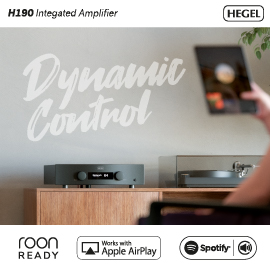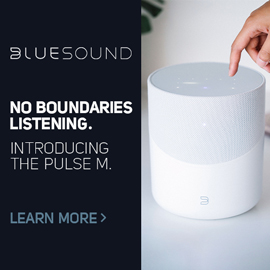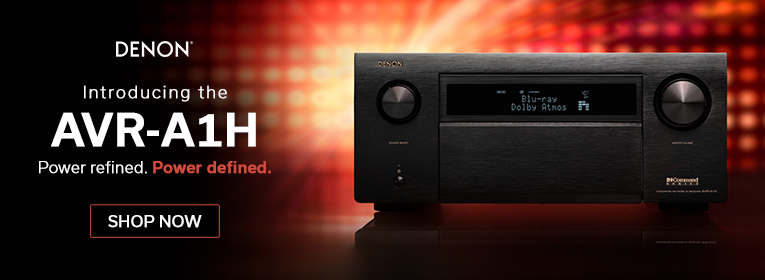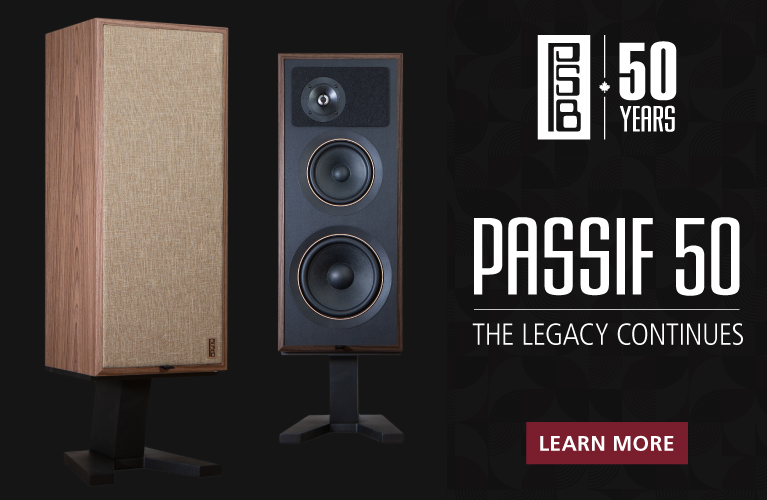
 I’ve been worrying the bone of this essay for some weeks now, anxious about how to characterize a product that’s awakened me to the brave new world of high-resolution digital. I’ve been a Luddite for quite some time, contemptuous of MP3 sound, derisive of how servers and computers scramble up the order of my beloved operas, symphonies, and concertos -- and intimidated by the price tags of what had, until recently, been the unreachable stars of seriously good-sounding digital playback: dCS, Playback Designs, EMM Labs, even Reimyo (back in the day). But a small flotilla of affordable and compact USB DACs has been launched on the high-end market, each ship in the fleet apparently delivering remarkable performance. How remarkable? Well, an editor whose ears I trust said he knew of a $2500 DAC whose sound just about equaled that of the $10,999 dCS Debussy. “Really?” I said, taking notice. Next thing I knew, I’d agreed to review the Hegel HD25.
I’ve been worrying the bone of this essay for some weeks now, anxious about how to characterize a product that’s awakened me to the brave new world of high-resolution digital. I’ve been a Luddite for quite some time, contemptuous of MP3 sound, derisive of how servers and computers scramble up the order of my beloved operas, symphonies, and concertos -- and intimidated by the price tags of what had, until recently, been the unreachable stars of seriously good-sounding digital playback: dCS, Playback Designs, EMM Labs, even Reimyo (back in the day). But a small flotilla of affordable and compact USB DACs has been launched on the high-end market, each ship in the fleet apparently delivering remarkable performance. How remarkable? Well, an editor whose ears I trust said he knew of a $2500 DAC whose sound just about equaled that of the $10,999 dCS Debussy. “Really?” I said, taking notice. Next thing I knew, I’d agreed to review the Hegel HD25.
Background
Established in the mid-1990s, Hegel Music Systems is a Norwegian manufacturer of audio electronics that has been making quite a splash lately with its excellent-sounding but relatively affordable gear. I’ve been very impressed with their amps and preamps at audio-show demos, but hadn’t had a chance to hear any Hegel components in my own system.
Recently, when I talked to Anders Ertzeid, Hegel’s director of marketing, about the HD25 DAC, he called it a “bastard” in terms of available DAC technology. He meant that it was a mix of two different performance levels. On the one hand, he said, there are thousands of entry-level DACs costing up to $1200. Hegel felt they could do more, but didn’t want to go all out and create something in the $5000-$6000 range -- digital technology is moving so fast that a pricy unit might soon be obsolete. Trying for something between those price points while pushing the boundaries as far as they could push them, Hegel focused on the analog stage, their engineers seeking, above all, resolution, while eschewing coloration. Other goals were to control three hobgoblins that perpetually plague digital sound: self-noise, analog distortion, and jitter, all of which conspire to mask the finer details of music.
Rather special, Ertzeid felt, are the features Hegel has built into the HD25. It supports all digital resolutions from 16-bit/44.1kHz to 24/192. It’s essentially plug‘n’play for Mac and has only to have a driver installed for PC users to handle resolutions above 24/96. A small switch on the HD25’s rear panel allows for lower-rez (16/44.1 to 24/96) or higher-rez (24/176.4 and 24/192) files. And the HD25 includes proprietary Hegel technology that lets it closely match its internal impedance with any coaxial cable specified at 75 ohms. Resolution and impedance matching guarantee the unit’s best possible sound.
A crucial decision was the choice of DAC chip. Ertzeid explained to me that Hegel had tried the vaunted ESS Sabre chip, but found it “not what was promised.” After many other trials, Hegel opted for AKM’s 32-bit 1399 chip, which they discovered was a lot more difficult to use, as it required special clocking and a good power supply. But the AKM was thought to be the best, affording low noise and very low high-frequency distortion. I found this interesting, as I think the highs in classical music and opera are the most difficult sounds for digital formats to render smoothly.
Description
This past spring, the Hegel HD25 arrived on my doorstep in an unassuming 14” x 12” x 6” cardboard box. Inside was the very handsome steel case of the HD25 itself, measuring 8.3”W x 2.35”H x 10.24”D, painted a matte black, and with a 3/8”-thick aluminum faceplate. Recessed into the faceplate is a small, blue LED display that specifies which of its selectable functions is operating. Silkscreened above the window is the Hegel logo. The HD25 has a very straightforward look and is extremely lightweight at 7.7 pounds. Inside the box was a user’s manual printed on coated stock. The warranty is three years parts and labor.
The HD25 is controlled two ways. One can simply double-tap the faceplate to select one of four inputs: USB, Optical, Coax 1 or 2. Or one uses the plastic remote control with blister buttons to select among multiple functions: input, volume, track advance/back, and a choice of two filters. As the remote is designed to work with other Hegel electronics, there are superfluous buttons for mute, eject, and another set of volume controls.
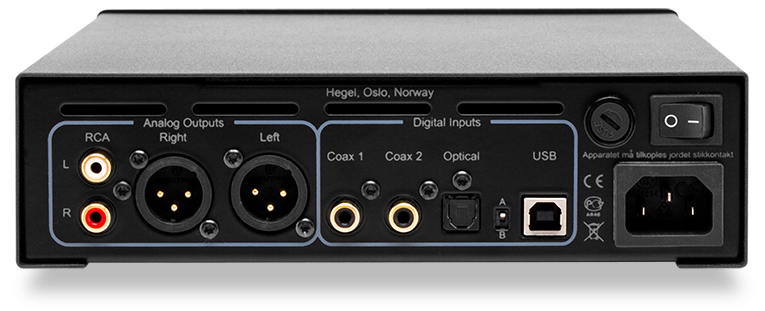
On the rear of the HD25 are an IEC inlet, four digital inputs (USB, Optical, Coax 1 and 2), a switch for resolution A (16/44.1 to 24/96) or B (16/44.1 to 24/192), and two sets of analog outs (RCA and XLR). To the right on the rear panel, next to the IEC, are the On/Off rocker switch and a fuse capsule.
Setup
I found that the HD25 is indeed plug’n’play, especially when used with a Mac. With its switch in the “A” position, the Hegel DAC plays all files from 16/44.1 through 24/96. For 24/176.4 and 24/192 files, PC users must download a driver from the Hegel website and go through the minor folderol of installing it. All a Mac user has to do to use the HD25’s hi-rez capability is to make sure the unit is powered off and the USB cable disconnected before flipping the small switch on the rear from “A” to “B.” C’est tout!
As for the rest, here’s the extent of what I had to do: run a USB cable from my iMac to the HD25’s USB input, a pair of RCA interconnects from the HD25 to my preamp’s inputs, and the digital cable from my Cary CD player to the HD25. For interface with the iMac, I went to the iMac’s Systems Preferences menu, clicked on Sound, then on Output, and then on Speaker/USB (the Mac alias for the HD25). Done!
The HD25’s remote is so tiny that it was a small fuss to use. It weighs about as much as a short stack of three or four credit cards, and is too small to operate single-handed. I had to hold it up like a tiny handset in my left hand, then hit its blister buttons with the fingers of my right hand. Plus, it was easy to lose track of -- it slid under my headphones, disappeared under stacks of business cards on my desk. So I resorted to using my iMac screen or my iPhone to select tracks, advance, backtrack, etc. For volume, I abandoned digital control via the Hegel remote (after setting the HD25’s output to 100%) and just reached over to my preamp, which was in a rack within arm’s reach of my desk where I sit when first setting up my listening. To control input selection, I just double-tapped the HD25’s faceplate, as I had it on my desk beside the iMac anyway. Once I got things going, I repaired to the easy chair on the other side of the room and used my iPhone as a remote.
After I’d set the Hegel’s digital volume control to max, the only function not controlled via iMac or iPhone was selecting the filter. I spent a little time trying these out, flipping between them by pushing the remote’s Filt button. Filter 1 seemed more flat and neutral across the audioband, while Filter 2 pushed the midrange a smidge more forward, accentuating dynamic contrasts as well, which I preferred. But the differences were slight.
I tried various signal and digital cables during the review period, and while all worked well, I found that the following combination sounded the smoothest with the HD25: Wireworld Platinum Starlight USB cable, my reference Siltech Classic Anniversary 330i RCA interconnects, and Boomslang digital cable from Snake River Audio.
Sound
Since I’d received the review sample of the HD25 from another reviewer, it was already fully broken in. I thought it sounded exceptional -- rich and easeful and exactly my thing. It was wondrous with classical strings, resolving and clear with operatic and jazz voices, and terrific with 1950s and ’60s combo jazz. It was good with rock and blues too. In fact, there wasn’t any kind of music it didn’t sound good with -- something unusual among audio components. I’ve found that some phono cartridges -- and step-ups and phono stages -- sound better with jazz and solo voices, while others are more suited to the energy of rock, and others are better with symphonic strings. The same goes for a lot of CD players. But the Hegel HD25 was one of the most versatile sources I’ve ever heard in terms of its suitability for a wide variety of musical genres.
Because I’m fairly new to computer audio, most of my digital library at the start of the listening period consisted of files ripped from CDs to Apple Lossless at 16/44.1, for which resolution Hegel recommends the HD25’s A setting.
From the Rolling Stones’ Stripped, an acoustic tour de force, I played the classic “Street Fighting Man” and was immediately struck by the great rhythm section -- acoustic guitar, bass, and kick drum just whacking down on the beat together. They sounded thunky and chunky, while Mick Jagger’s voice swooped down in dynamic accents right on the beat too. I’ve played this track from CD scores of times over the years, and it always bothered me that the instruments just never seemed in sync -- the timing seemed slightly off or mushy. That was not the case here. Pace, rhythm, and timing (PRaT) were superb, the Stones’ magically coherent incoherence coming through.
Vivaldi’s compositions can be just as challenging to a system in terms of timing and precision. A particularly difficult piece is the aria “In furore iustissimae irae,” RV 626, from the disc of that title and sung by soprano Sandrine Piau, with Ottavio Dantone conducting the Accademia Bizantina. The period-style strings had speed, good body, superb clarity without etch, and set an amazingly forceful pace behind Piau’s virtuosity. Her sudden, palpitating high notes hit every accent without graying out or smearing and were forcefully answered by the violins as they exchanged passage after thrilling passage. In general, the HD25 sounded great with baroque instrumental ensembles, always rendering them with tremendous drive and brio and a satisfying fullness of tone.
The H25 sounded especially wondrous with a variety of jazz tracks, ranging from standbys like “So What,” from Miles Davis’s Kind of Blue; and “Make Someone Happy,” from Bill Evans at Town Hall; to “Sue’s Changes,” from Charles Mingus’s Changes One. Unfailingly, the music was tonally saturated and punchy, with fine shadings of instrumental timbres. For example, there was a great and sensuous ambience to “The Look of Love,” from Diana Krall’s Live in Paris. The electric guitar and bass created a fine pulse that underlay the music, as Krall’s piano added trilling filigree and chiming ornaments to Bacharach’s melody. Her voice sounded by turns breathy and smoky, changing tones and timbres to suit the emotional shifts in this seductive song, at times even tightening to a clenched, throaty tease. The HD25 tracked her every whisk and whisper.

About midway through my listening, my curiosity about hi-rez digital audio now piqued, I began buying hi-rez downloads from sites like HDtracks, Channel Classics, and eClassical. Usually, I’d download these as FLAC files and convert them to ALAC using XLD, a free program I downloaded. With resolutions ranging from 24/44.1 to 24/192, these new downloads brought a salutary change to my listening. I finally broke through the brick wall of “Red Book” resolution. The sound only grew in sophistication, nuance, dynamic power, and emotional effect, all of which added up to a far more natural sound.
One of the first hi-rez tracks I listened to was an old favorite, “The Boxer,” from Simon and Garfunkel’s Greatest Hits (24/96 FLAC, CBS Mastersound). It felt strange to buy only one song from an album -- when I was growing up, LPs were the only format, and then I got used to buying albums on CD. But what I heard was wonderfully spacious, with clarity and lots of air around the duo’s voices. Art Garfunkel’s already ethereal tone was especially delicate and airy as he sang harmony, while Simon’s voice, which carried the melody, was sweet and mellow. There was lots of space around Simon’s intricately plucked guitar notes, and the imaging was solid and stable. Throughout, there was precision without edge or any analytic quality. And when Hal Blaine’s muted kick drum added its distinctive ca-thunk-tunk padding to the beat, it sounded mellow and full. Finally, I heard something on this familiar track I’d never noticed before -- someone rapping clearly and rhythmically on the top of an acoustic guitar -- a lovely effect that complemented the more obvious soft squawk on the downbeat from a comical squeeze toy. Of all the sounds, only the strings offended, sounding so bright in the final chorus that I at first mistook them for synth -- computer generated. But the harmonizing voices of those old boys from Queens sounded rousing at the end.
While not a voracious rock listener these days, I was a bigger fan in my youth, when Led Zeppelin was all the rage. Feeling nostalgic and curious to hear how the HD25 would fare with Zep in hi-rez, one day I downloaded their early hit (1969), “Whole Lotta Love” (24/192 FLAC, Atlantic/Classic). I wasn’t disappointed. Jimmy Page’s electric guitar intro rocked the hell out of my room. John Paul Jones’s bass thumped and rumbled with authority. Then Robert Plant’s stagy falsetto came through the rough mix clear as a black cat moan. Finally, John Bonham’s drums kicked in, Plant’s singing riding just above the driving mix as guitar and drums locked down on the rhythm together. I tried to ignore all the studio manipulation in this track -- Plant’s voice dodging around the soundstage, Page’s gimmicky guitar glissandos flying from the left to the right speaker and back again -- preferring to revel in the big, faux-stadium sound the track made in my listening room. And boy, was it ever impressive!
All well and good. But for me, the real test of any audio component is how it fares with the music I love best -- classical. I listened to a number of tracks -- complete works this time, not single arias or movements. I thought older recordings transferred to what was advertised as “audiophile resolution” files (at least 24/88.2) were all right, but nothing special. These were mainly classic recordings from RCA’s Living Stereo series. But the newer recordings from Channel Classics, Pentatone, Harmonia Mundi, Reference, and BIS just knocked me out.
Of these, I thought exemplary a recording of the Budapest Festival Orchestra, conducted by Iván Fischer, performing Mahler’s Symphony No.6 (24/88.2 FLAC, Channel Classics). In the first movement, Allegro energico, ma non troppo, what first struck me was the superb string tone. There were both detail and warmth in the violins, as well as an appropriate level of bite without etch or glass in the uppermost registers, and great gravitas from the double basses. Drumstrokes were authoritative, with superb timing. Woodwinds had a penetrating treble clarity. Throughout this bristling movement, lovely harmonics from all sections of the orchestra bloomed out into my listening room. The midrange was rich but fabulously delicate in the languorous pastoral passages, and forceful and energetically forward in the tuttis, as it should be. A theme traveled beautifully from the strings to the brass in various passages, with violins at first setting it, then the brass, trailing clouds of glory, picking it up in a lovely continuity of pitch but a startling difference in timbre. The movement at times had a Brahmsian grandiosity and sweep, and the violins were considerably and consistently more open and lifelike than I heard from 16/44.1 downloads or the CD of this recording. All in all, there were more depth and clarity than I was used to hearing from digital. The experience was the best resolution and extension I’d yet heard from a digital recording.
Comparison
I’ve owned an Eximus DP1 USB DAC ($3195) for about a year now, and though I hadn’t tried listening to hi-rez files with it before this review, I’ve enjoyed using it with my iMac while dipping a toe in computer audio. A preamp and head amp as well, the Eximus has many features the Hegel HD25 does not. On its front panel are a fully ergonomic set of control buttons and switches, a master volume knob with a wide sweep, a 1/4” headphone jack, auxiliary analog input via a mini-jack, and upsampling to 96 or 192kHz; on the rear panel are another auxiliary analog input (RCA) and two auxiliary digital inputs in addition to the same number of coaxial and optical inputs as on the HD25. The DP1 can serve as the hub for a pretty fine desktop system and as a USB DAC for a (near) reference-level computer system. It’s about the same size (8”W x 2.4”H x 11.45”D) and weight (under ten pounds) as the Hegel HD25, so it, too, fits easily on a desk. There’s no remote, but I can easily operate all functions by hand -- I positioned it within arm’s reach on my desk. The Eximus costs $695 more than the Hegel and, unlike the black-only HD25, comes only in silver.
It’s in features and flexibility that I rate the Eximus DP1 higher than the Hegel HD25. I have to admit, the DP1’s headphone output comes in handy late at night, when my wife wants to watch movies and I’m in my study (adjacent to the living room), listening to music. And on the long writing retreats away from home that I sometimes take, the DP1 is terrific to set up as the center of a compact desktop system that can travel with me. The DP1 is not only very versatile, it’s as easy to set up as the HD25.
As far as 16/44.1 sound was concerned, though, the Hegel was an exceptional performer. Overall, it tended toward more richness and warmth than the Eximus, which sounded leaner. To my ear, the HD25 had an ease of sound consistently better than that of “Red Book” CDs, even with 16/44.1 files ripped from CDs, whereas the DP1 sounded about the same as CD on 16/44.1. Using my Cary 303/300 CD player as only a disc transport and playing CDs, I consistently preferred the Hegel HD25’s sound over the Eximus DP1’s when I used the coaxial inputs of both, though the Eximus might have had a touch more drive.
With hi-rez files, however, the differences were more complicated and had to be ferreted out in careful comparisons. I switched back and forth between the two DACs by alternately connecting each with the same pair of RCA interconnects that fed my Lamm Industries LL2.1 preamp’s direct inputs. Then, I’d open up Systems Preferences on my iMac’s desktop and select either “Speaker” (for the HD25) or “XMOS USB 2.0 Audio Out” (for the DP1).
Playing hi-rez files ranging from 24/88.2 to 24/192, I preferred the Hegel HD25 to the Eximus DP1 with classical and other acoustic music for the smoothness of the Hegel’s midrange and the consistent absence of high-frequency distortion. It had such a clean top that orchestral strings invariably sounded open and operatic voices pure and dynamically expressive. However, I preferred the DP1 with electric rock and blues as it had more drive, sparkle, and jump. And if I eschewed use of the DP1’s upsampling capabilities, especially with hi-rez files, I found that, with orchestral music, it approached the openness of sound I heard through the HD25.
For example, when I listened to Fischer’s recording of the first movement of Mahler’s Symphony No.6, strings sounded harsh at the DP1’s 24/192 upsampling setting, bright at 24/96, and more natural and spacious with no upsampling at all. Yet I still preferred the HD25’s sound with classical music -- it was in another league.
But the Eximus DAC sounded much more immediate and punchy with Led Zep’s “Whole Lotta Love.” Plant’s voice jumped into the room, forward of the speakers, and Page’s guitar was grittier, crisper, more crackling with energy. I thought it rocked. The Hegel had a smoother and dynamically more subdued presentation, with Plant’s voice sounding deeper in the mix and Page’s guitar not as flashy or biting. The Hegel’s Filter 2 setting had slightly more bass extension and slam.
“Track B: Duet Solo Dancers,” from Charles Mingus’s The Black Saint and the Sinner Lady (24/96 FLAC, Impulse!), starts off with a lovely and lugubrious piano backed by a languorous horn chorus. It’s followed by a brilliant collage of alto and baritone saxes at the left of the soundstage, against an organized cacophony of tuba, trombone, and trumpet to the right. Then, just past halfway in, the trumpet takes a howling solo with plunger mute. With no upsampling, the DP1 presented the piano as clearer and more forward than did the HD25 and better defined the instruments not only in the soundstage, but also in terms of the mix, differentiating their tones and timbres. In short, the Eximus DAC was more resolving. At the same time, the Hegel sounded sweeter and more “musical.”
Simon and Garfunkel’s “The Boxer” fared well through both DACs, the Eximus again doing best with no upsampling, the duo’s voices sounding delicate, intricately woven in harmony, and closer to the Hegel HD25’s superior, cleaner, airier sound. Again, as with the Mahler and Led Zep, the Hegel’s Filter 2 gave the music a very slight push in midrange forwardness and dynamic contrasts, and sounded better to me.
Conclusion
Both the Hegel Music Systems HD25 and Eximus DP1 are splendid products. I could easily live with either. Each has its strong points, the Eximus winning in features and flexibility, the Hegel in presenting a sound that I consistently preferred for acoustic music and that was good with all genres of music. However, if your meat is electric rock and blues, I suspect you’ll prefer the Eximus DP1. And if you plan to use headphones and need a USB DAC as a hub for a computer audio system, the Eximus is a solid choice.
But I really enjoyed the way the Hegel HD25 sounded with the music I love best: classical. Orchestral strings sounded consistently silky and sweet, especially with hi-rez files, and there was an unmistakably natural ease and dynamic immediacy in how it presented any acoustic music. It introduced me to a whole new format of sound: hi-rez downloads. It flat thrilled me to explore these new riches -- the best digital sound I’ve ever heard. If I had the extra cash, I’d get the Hegel HD25 right away. Affordably priced, with plug’n’play installation, and easy to operate, it’s an excellent product and a gateway to high performance in computer-based digital playback.
. . . Garrett Hongo
garretth@soundstagenetwork.com
Associated Equipment
- Analog sources -- TW-Acustic Raven Two turntable and 10.5 tonearm with Zyx Airy 3 cartridge (0.24mV); Ortofon RS-309D tonearm with Ortofon 90th Anniversary SPU (0.3mV), Cadenza Mono (0.45mV), and Mono CG 25 DI Mk.II (1.5mV) cartridges
- Digital sources -- Cary 303/300 CD player; Apple iMac running OS X Mountain Lion, iTunes, and Amarra 2.5 with Eximus DP1 USB DAC
- Preamplifiers -- deHavilland Mercury 3, Lamm Industries LL2.1 line stages; Herron VTPH-2 phono stage; Music First, Tron 7, Ortofon ST M-25 step-up transformers
- Power amplifiers -- deHavilland KE50A monoblocks, VAC PA-100/100 stereo amp
- Speakers -- Von Schweikert Audio VR-44 Aktive
- Speaker cables -- Siltech 330L with 330L jumpers, Shunyata Research Python with Python jumpers
- RCA Interconnects -- Siltech 330i, Shunyata Research Python, Audience Au24SE, Auditorium 23
- USB cables -- Wireworld Silver Starlight, Cardas Clear, Belkin Gold
- Digital cables -- Snake River Audio Boomslang, Shunyata Research Python, Wireworld Starlight
- Power cords -- Siltech Ruby Hill II and SPX-800, Cardas Golden Reference, Harmonix XDC Studio Master, Silent Source Signature
- Power conditioner -- Audience ar6-TSS with Au24 PowerChord
- Accessories -- Box Furniture S5S five-shelf rack in sapele, HRS damping plates, edenSound FatBoy dampers, Winds VTF gauge
Hegel Music Systems HD25 Digital-to-Analog Converter
Price: $2500 USD.
Warranty: Three years parts and labor.
Hegel Music Systems
P.O. Box 2, Torshov
NO-0412 Oslo
Norway
Phone: +47 22-60-56-60
Fax: +47 22-69-91-56
E-mail: info@hegel.com
Website: www.hegel.com
North American distributors:
USA
Hegel Music Systems USA
336 Wilbraham Road
Hampden, MA 01036
Phone: (641) 209-3210
Fax: (641) 209-3076
E-mail: ben@hegel.com
Website: www.hegel.com
Canada
VMAX Services
CP 8, 1217 Greene Ave.
Montreal, Quebec H3Z 2T1
Phone: (541) 931-1880
Fax: (541) 931-8891
E-mail: info@vmax-services.com
Website: www.vmax-services.com





